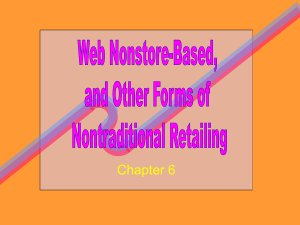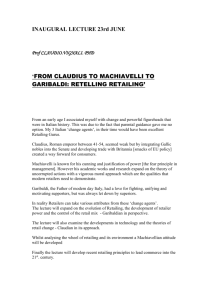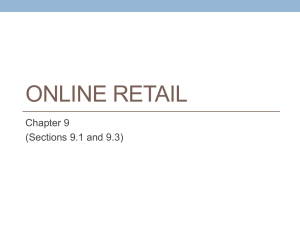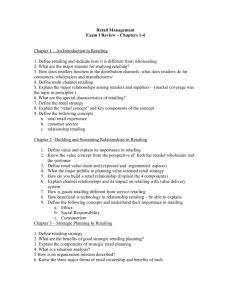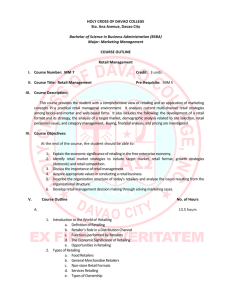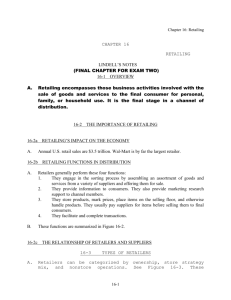Chapter 6
advertisement
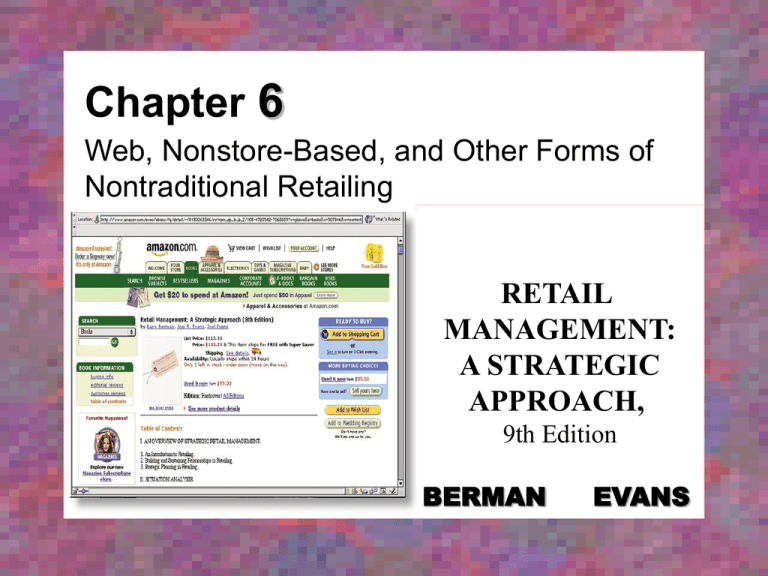
Chapter 6 Web, Nonstore-Based, and Other Forms of Nontraditional Retailing RETAIL MANAGEMENT: A STRATEGIC APPROACH, 9th Edition BERMAN EVANS Chapter Objectives To contrast single-channel and multichannel retailing To look at the characteristics of the three major retail institutions involved with nonstore-based strategy mixes: direct marketing, direct selling, and vending machines – with an emphasis on direct marketing 6-2 Chapter Objectives_2 To explore the emergence of electronic retailing through the World Wide Web To discuss two other nontraditional forms of retailing: video kiosks and airport retailing 6-3 Figure 6.1 Approaches to Retailing Channels 6-4 Figure 6.2 Home Depot 6-5 Nonstore Retailing Retailing strategy that is not storebased It exceeds $300 billion annually 78% comes from direct marketing Web-based retailing is fastest growing area 6-6 Nontraditional Retailing Nontraditional retailing also includes formats that do not fit into the store and non-store based categories: Video kiosks Airport retailing 6-7 Direct Marketing Customer is first exposed to a good or service through a nonpersonal medium and then orders by mail, phone, fax, or computer Annual U.S. sales exceed $235 billion Other leading countries include *France * Japan * Germany *Italy * Great Britain 6-8 Characteristics of Direct Marketing Customers • • • • 6-9 Married Upper middle class 36-50 years old Desires convenience, unique merchandise, good prices Direct Marketing Categories GENERAL SPECIALTY • offer full lines of • offer narrow product products from clothing lines to housewares – J.C. Penney – QVC 6-10 – L.L. Bean – Franklin Mint Figure 6.3 Micro Warehouse 6-11 Strategic Business Advantages of Direct Marketing Reduced costs Lower prices Large geographic coverage Convenient to customers Ability to pinpoint customer segments Ability to eliminate sales tax for some Ability to supplement regular business without additional outlets 6-12 Strategic Business Limitations of Direct Marketing Products cannot be examined prior to purchase Costs may be underestimated Response rates to catalogs under 10% Clutter exists Long lead time required Industry reputation sometimes negative 6-13 Database Retailing Collection, storage, and usage of relevant customer information * name * address * background * shopping interests * purchase behavior Observation of 80-20 rule 6-14 Emerging Trends Evolving activities Changing customer lifestyles Increasing competition Increasing usage of dual distribution channels Changing media roles, technological advances, and global penetration 6-15 Selection Factors Company reputation and image Ability to shop whenever consumer wants Types of goods and services Availability of toll-free phone number or Web site for ordering Credit card acceptance Speed of promised delivery time Competitive prices Satisfaction with past purchases and good return policy 6-16 TV Retailing 6-17 Figure 6.4 Executing a Direct Marketing Strategy 6-18 Media Selection Printed catalogs Direct-mail ads and brochures Inserts with monthly credit card and other bills (statement stuffers) 6-19 Freestanding displays Ads or programs in mass media Banner ads or hot links on the Web Video kiosks Outcome Measures Overall Response Rate Average Purchase Amount Sales Volume by Product Category Value of list brokers 6-20 Table 6.1 Snapshot of U.S. Direct Selling Industry M a jo r P ro d u c t G ro u p s % o f In d u s try H o m e / fa m ily c a re p ro d u c ts 3 3 .7 P e rs o n a l c a re p ro d u c ts 2 6 .4 S e rv ic e s 1 6 .9 W e lln e s s p ro d u c ts 1 6 .5 L e is u re / e d u c a tio n a l p ro d u c ts 6-21 6 .5 Table 6.1 Snapshot of U.S. Direct Selling Industry P la c e o f S a le s % o f In d u s try In th e h o m e 6 4 .4 O ve r th e p h o n e 1 4 .7 In a w o rk p la c e 8 .7 O ve r th e In te rn e t 5 .5 O th e r 6 .7 6-22 Figure 6.5 Direct Selling and Mary Kay 6-23 The Role of the Web Project a retail presence Enhance image Generate sales Reach geographically-dispersed customers Provide information to customers Promote new products Demonstrate new product benefits 6-24 The Role of the Web_2 Provide customer service (e.g., e-mail) Be more “personal” with consumers Conduct a retail business efficiently Obtain customer feedback Promote special offers Describe employment opportunities Present information to potential investors, franchisees, and the media 6-25 Figure 6.6 Web-Based U.S. Retail Sales 6-26 Figure 6.8 Five Stages of Developing a Retail Web Presence 1. Brochure Web Site 2. Commerce Web Site 3. Integrated Web Site 4. The ‘Webified’ Store 5. Site Integrated with Manufacturer Systems 6-27 Figure 6.9 A Checklist of Retailer Decisions in Utilizing the Web 6-28 Reasons Using the Web – information – entertainment – interactive communications 6-29 Shopping Online – selection – prices – convenience – fun Reasons NOT to Shop Online Trust Fear Lack of security Lack of personal communication 6-30 Recommendations for Web Retailers Develop or exploit a well-known, trustworthy retailer name Tailor the product assortment for Web shoppers Enable the shopper to click as little as possible Provide a solid search engine Use customer information 6-31 Figure 6.12 Borders’ Title Sleuth Video Kiosk 6-32 Features of Airport Retailing Large group of prospective shoppers Captive audience Strong sales per square foot of retail space Strong sales of gift and travel items Difficulty in replenishment Longer operating hours Duty-free shopping possible 6-33 Figure 6.13 Airport Retailing and Waldenbooks 6-34

